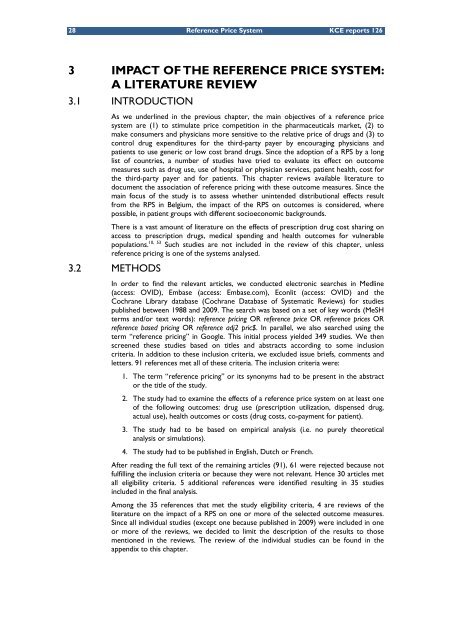The reference price system and socioeconomic differences in ... - KCE
The reference price system and socioeconomic differences in ... - KCE
The reference price system and socioeconomic differences in ... - KCE
You also want an ePaper? Increase the reach of your titles
YUMPU automatically turns print PDFs into web optimized ePapers that Google loves.
28 Reference Price System <strong>KCE</strong> reports 126<br />
3 IMPACT OF THE REFERENCE PRICE SYSTEM:<br />
A LITERATURE REVIEW<br />
3.1 INTRODUCTION<br />
As we underl<strong>in</strong>ed <strong>in</strong> the previous chapter, the ma<strong>in</strong> objectives of a <strong>reference</strong> <strong>price</strong><br />
<strong>system</strong> are (1) to stimulate <strong>price</strong> competition <strong>in</strong> the pharmaceuticals market, (2) to<br />
make consumers <strong>and</strong> physicians more sensitive to the relative <strong>price</strong> of drugs <strong>and</strong> (3) to<br />
control drug expenditures for the third-party payer by encourag<strong>in</strong>g physicians <strong>and</strong><br />
patients to use generic or low cost br<strong>and</strong> drugs. S<strong>in</strong>ce the adoption of a RPS by a long<br />
list of countries, a number of studies have tried to evaluate its effect on outcome<br />
measures such as drug use, use of hospital or physician services, patient health, cost for<br />
the third-party payer <strong>and</strong> for patients. This chapter reviews available literature to<br />
document the association of <strong>reference</strong> pric<strong>in</strong>g with these outcome measures. S<strong>in</strong>ce the<br />
ma<strong>in</strong> focus of the study is to assess whether un<strong>in</strong>tended distributional effects result<br />
from the RPS <strong>in</strong> Belgium, the impact of the RPS on outcomes is considered, where<br />
possible, <strong>in</strong> patient groups with different <strong>socioeconomic</strong> backgrounds.<br />
<strong>The</strong>re is a vast amount of literature on the effects of prescription drug cost shar<strong>in</strong>g on<br />
access to prescription drugs, medical spend<strong>in</strong>g <strong>and</strong> health outcomes for vulnerable<br />
populations. 10, 53 Such studies are not <strong>in</strong>cluded <strong>in</strong> the review of this chapter, unless<br />
<strong>reference</strong> pric<strong>in</strong>g is one of the <strong>system</strong>s analysed.<br />
3.2 METHODS<br />
In order to f<strong>in</strong>d the relevant articles, we conducted electronic searches <strong>in</strong> Medl<strong>in</strong>e<br />
(access: OVID), Embase (access: Embase.com), Econlit (access: OVID) <strong>and</strong> the<br />
Cochrane Library database (Cochrane Database of Systematic Reviews) for studies<br />
published between 1988 <strong>and</strong> 2009. <strong>The</strong> search was based on a set of key words (MeSH<br />
terms <strong>and</strong>/or text words): <strong>reference</strong> pric<strong>in</strong>g OR <strong>reference</strong> <strong>price</strong> OR <strong>reference</strong> <strong>price</strong>s OR<br />
<strong>reference</strong> based pric<strong>in</strong>g OR <strong>reference</strong> adj2 pric$. In parallel, we also searched us<strong>in</strong>g the<br />
term “<strong>reference</strong> pric<strong>in</strong>g” <strong>in</strong> Google. This <strong>in</strong>itial process yielded 349 studies. We then<br />
screened these studies based on titles <strong>and</strong> abstracts accord<strong>in</strong>g to some <strong>in</strong>clusion<br />
criteria. In addition to these <strong>in</strong>clusion criteria, we excluded issue briefs, comments <strong>and</strong><br />
letters. 91 <strong>reference</strong>s met all of these criteria. <strong>The</strong> <strong>in</strong>clusion criteria were:<br />
1. <strong>The</strong> term “<strong>reference</strong> pric<strong>in</strong>g” or its synonyms had to be present <strong>in</strong> the abstract<br />
or the title of the study.<br />
2. <strong>The</strong> study had to exam<strong>in</strong>e the effects of a <strong>reference</strong> <strong>price</strong> <strong>system</strong> on at least one<br />
of the follow<strong>in</strong>g outcomes: drug use (prescription utilization, dispensed drug,<br />
actual use), health outcomes or costs (drug costs, co-payment for patient).<br />
3. <strong>The</strong> study had to be based on empirical analysis (i.e. no purely theoretical<br />
analysis or simulations).<br />
4. <strong>The</strong> study had to be published <strong>in</strong> English, Dutch or French.<br />
After read<strong>in</strong>g the full text of the rema<strong>in</strong><strong>in</strong>g articles (91), 61 were rejected because not<br />
fulfill<strong>in</strong>g the <strong>in</strong>clusion criteria or because they were not relevant. Hence 30 articles met<br />
all eligibility criteria. 5 additional <strong>reference</strong>s were identified result<strong>in</strong>g <strong>in</strong> 35 studies<br />
<strong>in</strong>cluded <strong>in</strong> the f<strong>in</strong>al analysis.<br />
Among the 35 <strong>reference</strong>s that met the study eligibility criteria, 4 are reviews of the<br />
literature on the impact of a RPS on one or more of the selected outcome measures.<br />
S<strong>in</strong>ce all <strong>in</strong>dividual studies (except one because published <strong>in</strong> 2009) were <strong>in</strong>cluded <strong>in</strong> one<br />
or more of the reviews, we decided to limit the description of the results to those<br />
mentioned <strong>in</strong> the reviews. <strong>The</strong> review of the <strong>in</strong>dividual studies can be found <strong>in</strong> the<br />
appendix to this chapter.
















